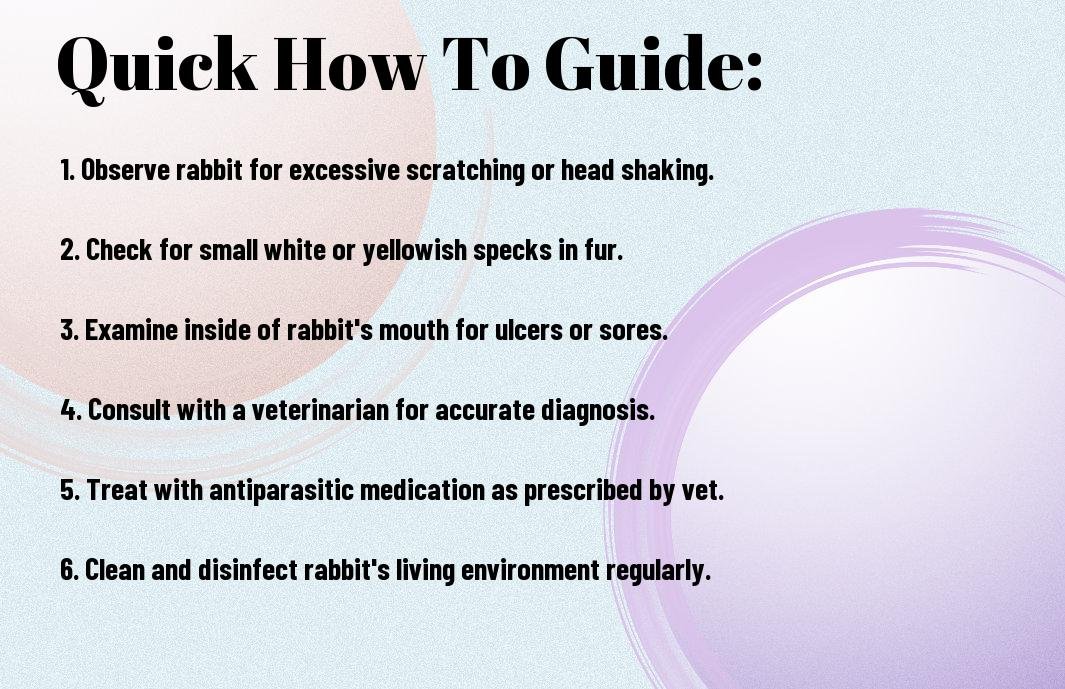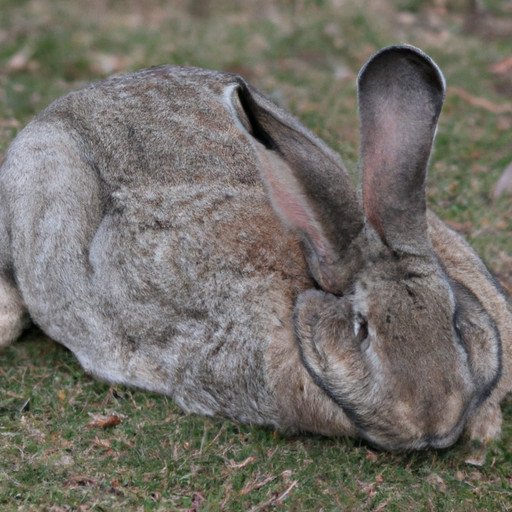Do you know that mites and fleas can infest your rabbit’s muzzle causing discomfort and health issues? If you notice your rabbit scratching at its nose or see small black specks around the nostrils, it’s important to act quickly. Identifying and treating muzzle parasite infestations is crucial for the health and well-being of your pet. In this guide, you will learn how to spot the signs of muzzle parasite infestation in rabbits and how to effectively treat it to ensure your rabbit stays healthy and happy.
Key Takeaways:
- Regular Inspection: It is essential to regularly inspect your rabbit’s muzzle and facial area for any signs of parasite infestation, such as crusty skin, scabs, or excessive scratching.
- Consult a Veterinarian: If you suspect your rabbit has a muzzle parasite infestation, it is crucial to consult a veterinarian for proper diagnosis and treatment.
- Treatment Options: There are various treatment options available for muzzle parasite infestation in rabbits, including topical creams, oral medications, and cleaning the affected area.
- Preventive Measures: To prevent muzzle parasite infestation, it is important to keep your rabbit’s living area clean, provide proper nutrition, and regularly groom and inspect your rabbit for any signs of parasites.
- Monitoring and Follow-Up: After treatment, it is essential to monitor your rabbit for any signs of re-infestation and follow up with your veterinarian as needed to ensure the parasite infestation is fully resolved.

How to Spot Muzzle Parasites Infestation
Some rabbits can fall victim to a muzzle parasite infestation, which can be uncomfortable for them and difficult for you to spot. By learning to recognize the signs of infestation, you can take steps to help your rabbit and prevent the spread of parasites to other pets.
Crucial Signs of Muzzle Parasites in Rabbits
The most common signs of muzzle parasite infestation in rabbits include excessive scratching or rubbing of the face, redness or irritation around the mouth and nose, hair loss or bald spots, and the presence of small black specks or crusts on the fur. If you notice any of these symptoms in your rabbit, it’s important to take action right away to address the infestation and relieve your pet’s discomfort.
Tips for Early Detection of Infestation
One of the most effective ways to detect a muzzle parasite infestation early is to regularly inspect your rabbit’s muzzle and face for any signs of irritation or unusual behavior. Additionally, you can use a flea comb to check for the presence of parasites or their eggs in your rabbit’s fur. This can help you catch infestations before they become severe and require more intensive treatment. You should also monitor your rabbit’s behavior for any changes in appetite or energy levels, as these can be signs of discomfort caused by parasites.
- Regularly inspect your rabbit’s muzzle and face for signs of irritation or unusual behavior.
- Use a flea comb to check for parasites or their eggs in your rabbit’s fur.
- Monitor your rabbit’s behavior for changes in appetite or energy levels.
This proactive approach can help you catch any infestations early and prevent them from causing your rabbit unnecessary discomfort.
Factors influencing Muzzle Parasite Infestation
Lastly, there are several factors that can influence the infestation of muzzle parasites in rabbits. Understanding these factors can help you take preventive measures to protect your rabbit. Some of the most common factors include:
- Environment: The living environment of your rabbit can greatly affect the risk of parasite infestation. This includes bedding, cleanliness of the living space, and exposure to other animals.
- Rabbit health: The overall health and immune system of your rabbit play a crucial role in determining their vulnerability to parasite infestation.
- Hygiene practices: Your hygiene practices and the regular grooming of your rabbit can also impact the likelihood of infestation.
Perceiving these influencing factors can help you take appropriate steps to minimize the risk of parasite infestation in your rabbit. For more information on common mites in rabbits, you can visit Common Mites of Your Rabbit and Small Animal Part I.
Environmental Factors and Infestation Rate
Environmental factors play a significant role in determining the infestation rate of muzzle parasites in rabbits. Factors such as the cleanliness of the living environment, exposure to other animals, and the type of bedding used can all influence the likelihood of infestation. Recognizing these factors can help you create a safer and healthier living environment for your rabbit.
Rabbit Health and Parasite Vulnerability
The overall health and immune system of your rabbit can greatly impact their vulnerability to muzzle parasites. A weakened immune system can make rabbits more susceptible to infestations, while strong overall health can act as a natural defense against parasites. It’s crucial to ensure that your rabbit receives proper nutrition and veterinary care to maintain their health and reduce the risk of parasite infestation.
How to Treat Muzzle Parasite Infestation
After identifying the presence of muzzle parasites in your rabbits, it is crucial to take immediate action to treat the infestation. Failure to do so can lead to serious health issues for your rabbits, including discomfort, pain, and potential complications. In this section, we will discuss the steps you can take to cure infected rabbits and best practices for parasite treatment.
Steps to Cure Infected Rabbits
If you suspect that your rabbits are infected with muzzle parasites, the first step is to isolate the affected rabbits from the rest of the herd to prevent the spread of parasites. Next, you should consult with a veterinarian who can provide a proper diagnosis and recommend the most effective treatment plan for your rabbits. The treatment may involve the use of medication to eliminate the parasites and relieve your rabbits from discomfort. It is important to follow the veterinarian’s instructions carefully and administer the treatment as prescribed to ensure the parasites are effectively eradicated.
Best Practices for Parasite Treatment
When treating muzzle parasite infestation in your rabbits, it is essential to maintain a clean and hygienic environment for your rabbits to prevent re-infestation. Regularly clean and disinfect their living quarters, including cages, hutches, and feeding areas. Additionally, you should closely monitor the affected rabbits for any signs of recurrence of the parasite infestation, such as scratching or rubbing their muzzle. If you notice any such signs, seek prompt veterinary assistance to address the issue before it worsens. Remember to practice good hygiene and preventive measures to protect your rabbits from future infestations.
Conclusion
So now you know how to spot and treat muzzle parasite infestation in your rabbits. By regularly checking your rabbits for symptoms, practicing good hygiene, and seeking prompt veterinary care, you can prevent and effectively treat muzzle parasite infestations. Remember to monitor your rabbits closely and consult with a veterinarian if you have any concerns about their health. With the right knowledge and care, you can keep your rabbits healthy and parasite-free.
FAQ
Q: What are the signs of muzzle parasite infestation in rabbits?
A: Common signs of muzzle parasite infestation in rabbits include excessive scratching or rubbing of the nose, thick discharge from the nostrils, sneezing, and visible irritation around the nasal area. In severe cases, you may also notice hair loss or crusty lesions on the muzzle. It’s important to monitor your rabbit for these symptoms and seek veterinary care if you suspect a muzzle parasite infestation.
Q: How can I treat muzzle parasite infestation in rabbits?
A: Treatment for muzzle parasite infestation in rabbits typically involves the use of topical or oral anti-parasitic medication prescribed by a veterinarian. Your vet may also recommend cleaning and disinfecting the affected area to prevent further irritation. Additionally, it’s important to address any underlying issues that may have led to the infestation, such as poor living conditions or stress. Following your vet’s instructions and completing the full course of treatment is crucial for effectively addressing muzzle parasite infestation in rabbits.
Q: How can I prevent muzzle parasite infestation in rabbits?
A: To prevent muzzle parasite infestation in rabbits, it’s essential to maintain clean living conditions for your pet. Regularly clean and disinfect their living area, and provide them with a balanced diet and plenty of fresh water. Additionally, keep an eye on your rabbit’s overall health and wellbeing, and address any underlying issues promptly. Avoid exposing your rabbit to potentially infested environments, such as areas with wild or stray rabbits. Regular veterinary check-ups and proper hygiene practices are key to preventing muzzle parasite infestation in rabbits.
